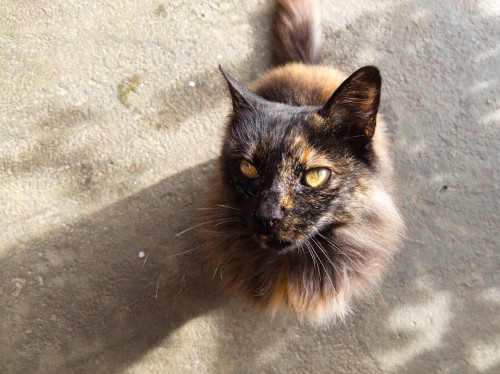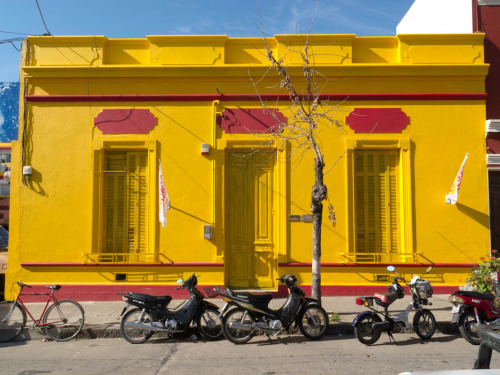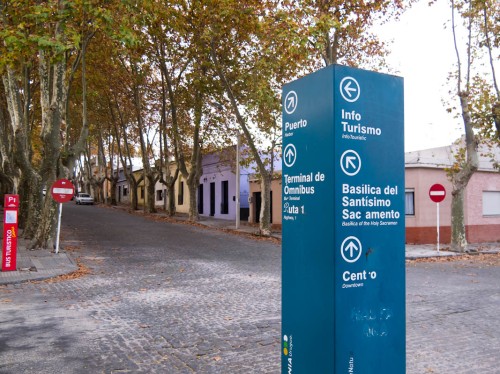misadventures in Cafayate
Abandoning Buenos Aires and big-city life, I retreated to the northwest corner of Argentina for more of the slow pace I had found in Uruguay.
The first few blocks around the center of Cafayate have paved streets; beyond that, it’s dirt roads in all directions, with gorgeous hunks of mountains at the ends of them. The town square is disproportionately large, containing a fountain and the biggest patches of unnaturally green grass to be found anywhere in the town. On the north side sits a massive pink church – again, disproportionately large given the size of the town, but it likely attracts parishioners from the surrounding hills as well.
I arrived here from Salta on one of the most beautiful 5-hour bus rides I’d ever taken (not knowing the bus rides were to get better), my backpack and I spilling out of the vehicle and into the dust, disoriented. We’d driven over mountains, through vineyards, and down tree-lined streets, the leaves blazing yellow as fall approached.
As I strapped on my pack and headed down the block, I heard another girl ask me (in English, of course – I generally am THAT obvious), “Where are you staying?”
We made fast friends in the way two people who find themselves alone in the same place do. After sharing a meal, some wine, and our latest romantic exploits (of course), we became roughly inseparable, and only parted ways several hours – and a submarino each – later.
In the courtyard of my hostel sat a big brick BBQ, which was used for an asado that evening, celebrating someone’s (whose?) birthday. We lined all the tables up in the kitchen and ate family-style – hostel guests, hostel employees, past hostel employees, and some other locals. I invited Amanda, we made even more friends, and I may have overindulged, which made for an interesting day on Sunday: Amanda and I hiked up an entire mountain, mostly on accident.
We had signed on for a “walk” to see three waterfalls along the Rio Colora’o. It would in fact be quite a stretch to call what we actually did a “walk.”
Arriving at the meeting point on time the following morning, Amanda and I remained very much alone until about 45 minutes later, when a small van pulled up. The square was empty; Argentines are not early risers. The man who’d booked us on the walk was driving the van, and our guide, Nahuel, sat in the back with us.
The three of us were deposited on the side of a dirt road, with one lone tree casting angled, early-morning shade. Amanda and I waved goodbye to the van and turned to Nahuel, our immediate futures in his 19-year-old hands. He spoke absolutely no English.
After scaling a 8-foot vertical rock face to gain the start of the trail, we padded along after Nahuel as we following a stream upward, a stream we ended up crossing no fewer than 20 times, even as it grew and turned into what one could arguably call a small river. We stumbled around cacti, climbed through tiny holes in vertical rock faces, and skittered along the trail, upward.
Nahuel was infinitely patient with us. He climbed like a mountain goat – quickly, no hands required – and spent quite a lot of time waiting for me and Amanda as we hesitated at all of the river crossings and gingerly stepped past steep drop-offs. We’d inevitably round a corner to find him perched gracefully on a rock, taking in the view as he waited. He was a good sport, though, and we took several selfies with him in order to document the adventure.
The first two waterfalls were fairly unimpressive. Nahuel gestured to each of them somewhat shyly, and Amanda and I took our obligatory photos of them. The third and final waterfall, though, gushed into a pool of considerable size, so we stopped here for a while, wading and appreciating what the morning’s efforts had gained us.
By the time we arrived back at the dirt road, we were exhausted, and Nahuel was completely unfazed. In the summer months, at the height of tourist season, he might do that hike twice a day, several times a week.
I had two more nights in Cafayate, and by the time I left, I felt like I could recognize 80% of the town. There is something comforting about being in a place that’s so far from home, but that can still feel familiar. In my last days here, I ran into people I knew walking across the square, or when passing the patio of a restaurant where they were having dinner. I even ran into Nahuel a couple of times and split an alfajor with him.
It is true that as a basic human desire, we crave community. We want to feel like we belong, to be accepted, to know and be known. Travel often removes this possibility by definition, and that can lead us to important and meaningful experiences – if we are willing to have them. We engage with people we otherwise wouldn’t, perhaps first out of necessity, or out of loneliness, as we struggle to live outside of our comfort zone – as an outsider in a foreign place.
This search for community is in fact the meat of all travel: Trusting people we don’t know. Saying yes. Admitting vulnerability and accepting comfort. Sitting down to a meal with strangers, and standing up as friends. The cultures of the world are so magnificently different that these moments of connection are the most thrilling shortcuts to the nature of our shared humanity: It is truly the best education.
A tourist enters a place knowing what memories he is there to collect; a traveler enters a place knowing only that something will happen to him there if he is brave enough to remain open to the possibilities.





















